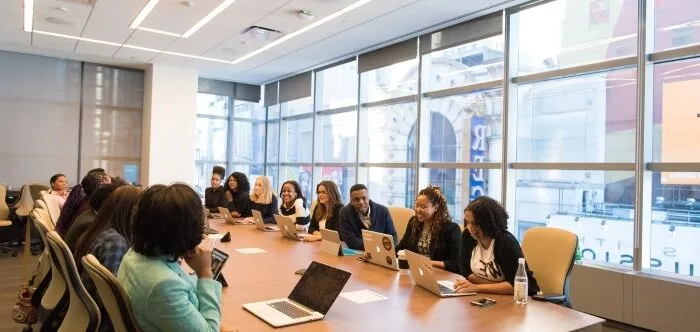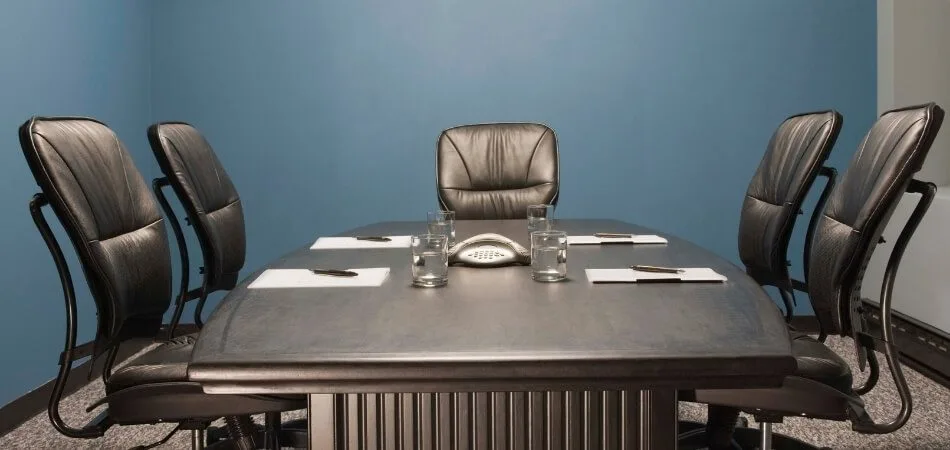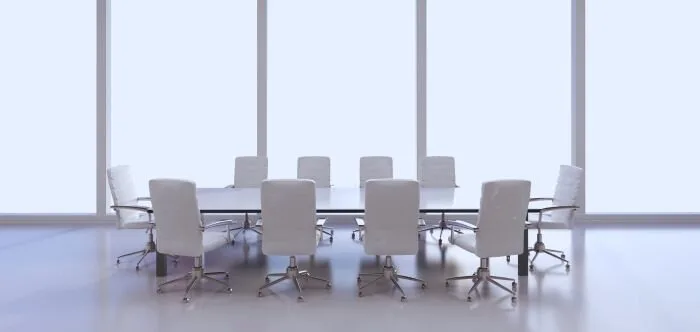A conference table is more than just a piece of furniture; it’s a central element in professional environments where ideas are shared and decisions are made. But what is a conference table used for?
Primarily, it serves as the hub for meetings, discussions, and critical decision-making processes in various settings like business offices, academic institutions, and government buildings. Its design and structure are tailored to enhance collaboration, encouraging face-to-face interaction among participants.
It also acts as an anchor for presentations and a platform for group activities, fostering a sense of unity and focus. Interested? Keep reading to discover more about the vital role conference tables play in professional and collaborative environments.
What is a Conference Table?
A conference table is a significant piece of furniture in any professional space. It’s designed to accommodate multiple people, fostering teamwork and discussion. Often large and stately, it becomes a centerpiece in rooms where important decisions are made.
In various settings like corporate offices, academic institutions, or government agencies, its presence is essential. The table facilitates effective communication and collaboration among team members or clients. It’s where strategies are formed, ideas are exchanged, and critical decisions are taken.
Apart from its functional use, the use of conference table also adds to the visual appeal of a meeting space. It reflects the organization’s style and values, often being customized to suit specific needs. Whether for a small team meeting or a large boardroom discussion, it plays an essential role in both function and design.
What is a Conference Table Used For?
A conference table is more than just a furniture piece; it’s a symbol of collaboration and decision-making in professional settings. Serving various purposes, it’s an indispensable element in meeting rooms. Here is the explanation of what is a conference table used for.
Facilitating Meetings and Discussions
Conference tables provide a comfortable setting for meetings and discussions. They can seat many people, encouraging inclusivity. These tables allow team members to share ideas and have productive conversations, making them essential for discussing and refining plans.
Decision-Making Hub
In business and organizational settings, these tables serve as the central point for critical decision-making. They host board members, executives, and teams who make strategic decisions. The table’s setting encourages a democratic and open environment. Here, every voice can be heard, and every opinion considered.
Promoting Collaboration
Collaboration is key to any successful venture, and conference tables facilitate this. By gathering individuals in a shared space, these tables encourage teamwork and collective problem-solving. They become a physical manifestation of unity and cooperation. The layout often encourages face-to-face interaction, essential for effective teamwork.
Hosting Clients and Guests
Conference tables also play a role in external relations, such as client meetings or interviews. They provide a professional setting for hosting guests, reflecting the organization’s image. The table’s design and placement can leave a lasting impression on visitors. It’s a space where partnerships are formed and nurtured.
Flexible for Various Settings
Not just limited to corporate environments, conference tables are flexible. They’re used in academic institutions for faculty meetings, and in government buildings for official gatherings. Each setting demands a different style and size, making these tables highly adaptable. Their design varies to suit the specific needs of each environment.
Anchor for Presentations and Workshops
Conference tables are essential for presentations and workshops. They offer a stable platform for laptops, projectors, and documents. In training sessions or seminars, these tables facilitate learning and interaction. Their central position in a room, combined with understanding conference style seating, makes them an ideal focal point for group activities.
Types of Conference Tables and their Benefits
Conference tables are crucial in shaping the dynamics of professional meetings and discussions. They come in various styles and designs, each offering unique benefits. Understanding the different types helps in choosing the right one for your space and needs.
Rectangular Conference Tables
The most common type is the rectangular conference table. It’s ideal for traditional and formal settings, offering a classic look. This shape supports a clear hierarchy, with heads of the table often perceived as key decision-makers. Its linear design facilitates direct communication across the table, enhancing interaction. The rectangular shape also allows for efficient use of space, accommodating more people. It’s a practical choice for most meeting rooms.
Round Conference Tables
These tables promote equality and inclusiveness in discussions. With no head at the table, they foster a friendly atmosphere for open communication. Their circular shape works well in smaller spaces, encouraging eye contact and teamwork during brainstorming sessions.
U-Shaped Conference Tables
They are excellent for training sessions and presentations. The open end of the table can be used for a focal presentation area. This setup allows a presenter to engage easily with each attendee. They also facilitate group discussions while maintaining a clear view of the presenter. U-shaped tables are great for workshops where interaction between the presenter and audience is key. They offer a functional design for educational and training environments.
Modular Conference Tables
For flexibility and adaptability, modular conference tables are the best. They can be reconfigured to suit different meeting sizes and styles. This type is ideal for dynamic and versatile workspaces, where the needs constantly change. Modular designs enable a customized setup for each meeting, fostering creativity and innovation. These tables can be easily moved and rearranged, promoting a collaborative and flexible working environment. They are perfect for companies with evolving space requirements.
Oval Conference Tables
It combines the structured design of rectangular tables with the inclusivity of round ones. They create a softer look and are less intimidating. This shape supports both formal and collaborative meetings, enhancing conversation flow and providing a modern, functional space.
Consideration While Choosing a Conference Table
When selecting a conference table, various considerations come into play, shaping its functionality and impact in your space. It’s not just about the size or shape; factors like design, material, and technological integration are crucial. Here are key points to consider to ensure you make the right choice:
- Size and Space: Ensure the table fits comfortably in your room, allowing easy movement around it. A too-large table can make a room feel cramped, hindering comfort and accessibility.
- Shape and Style: Choose a shape that complements the dynamics of your meetings. Different shapes, like round, rectangular, or U-shaped, influence communication and hierarchy in meetings.
- Material and Durability: Go for materials that balance aesthetics with practicality. High-quality, durable materials like solid wood or metal ensure longevity and a professional appearance.
- Technology Integration: Consider tables with built-in technology like charging ports or AV connectivity. This is crucial for modern businesses where digital tools are integral to meetings.
- Ergonomics and Comfort: Prioritize ergonomics to ensure comfort during long meetings. Tables with appropriate height and legroom make extended sitting less strenuous.
- Brand and Budget: Align your choice with budget constraints without compromising on quality. Reputable brands often offer a balance of quality, durability, and cost-effectiveness.
- Environmental Sustainability: For eco-conscious businesses, consider tables made from sustainable or recycled materials. This reflects your company’s commitment to environmental responsibility.
Remember, the best choice is one that aligns with your specific needs, reflects your brand’s image, and enhances the productivity of your meetings.
Essential Tips to Maintain Conference Table
Keeping a conference table well-maintained is essential for professionalism and functionality in your meeting space. Regular care helps preserve its appearance and increases its lifespan. Here are some important tips to ensure your conference table stays in excellent condition.
Regular Cleaning
To maintain the table’s pristine appearance, regular cleaning is essential. Use a soft cloth and appropriate cleaner for the material, whether it’s wood, glass, or metal. Avoid harsh chemicals that can damage the surface. Dusting it daily prevents the buildup of dirt and grime.
Immediate Spill Management
Act quickly when spills occur to prevent stains. Blot spills immediately with a dry cloth; avoid wiping as it can spread the liquid. For stubborn stains, use a mild cleaning solution suitable for the table’s material. Regularly check for any unnoticed spills, especially after meetings.
Avoid Excessive Weight
Don’t overload the table with heavy equipment or stacks of books. Excessive weight can cause warping or damage, especially on wooden tables. Use sturdy stands for projectors or computers to distribute weight evenly. Encourage users to be mindful of the table’s load capacity.
Protective Measures
Use coasters and placemats to prevent rings and scratches. This is especially important for wooden tables, where moisture can cause damage. Invest in a good quality table pad for added protection during activities. These small measures can significantly extend the table’s lifespan.
Regular Cleaning
To maintain the table’s pristine appearance, regular cleaning is essential. Use a soft cloth and appropriate cleaner for the material, whether it’s wood, glass, or metal. Avoid harsh chemicals that can damage the surface. Dusting it daily prevents the buildup of dirt and grime.
Immediate Spill Management
When spills happen, act quickly to prevent staining. Blot the spill immediately with a dry cloth instead of wiping, which can spread the liquid. For tough stains, use a mild cleaner that matches the table’s material and check for unnoticed spills regularly, especially after meetings.
Avoid Excessive Weight
Don’t overload the table with heavy equipment or stacks of books. Excessive weight can cause warping or damage, especially on wooden tables. Use sturdy stands for projectors or computers to distribute weight evenly. Encourage users to be mindful of the table’s load capacity.
Protective Measures
Use coasters and placemats to prevent rings and scratches, especially on wooden tables that can be damaged by moisture. Also, think about how your table will appear in event photos; incorporating effective conference photography strategies will help your table and meeting space look their best. Investing in a quality table pad adds extra protection during activities, significantly extending the table’s lifespan.
Mindful Usage
Encourage respectful and careful use of the table among staff and guests. Avoid using it as a support for standing or sitting. Discourage the use of sharp objects directly on the surface. A culture of mindfulness goes a long way in preserving the table’s condition.
Regular Inspections and Repairs
Periodically inspect the table for any signs of wear or damage. Address issues like loose screws, chipped edges, or unstable legs promptly. If the damage is beyond basic repair, consult a professional. Regular maintenance checks help in identifying and fixing problems early.
By following these simple yet effective maintenance tips, you can ensure that your conference table remains a valuable asset in your meeting space for years to come.
Frequently Asked Questions
Conference tables play an important role in professional settings, offering much more than just a surface for meetings. Below are some frequently asked questions that delve deeper into the various functions and benefits of conference tables.
How Does a Conference Table Support Team Collaboration?
A conference table fosters team collaboration by bringing participants together in a shared space. Its design encourages face-to-face interaction, enabling open communication and collective problem-solving, which are essential for successful teamwork and project execution.
Why Are Conference Tables Important for Client Meetings?
Conference tables provide a formal and professional setting for client meetings. They offer a dedicated space where discussions can be held, contracts signed, and partnerships formed, ensuring a positive impression and fostering strong business relationships.
Can a Conference Table Increase the Visual of a Meeting Room?
Yes, a well-chosen conference table can significantly increase the visual of a meeting room. It serves as a focal point, reflecting the organization’s style and values while contributing to a polished and professional atmosphere conducive to productive meetings.
How Does a Conference Table Facilitate Effective Presentations?
A conference table acts as an anchor for presentations by providing a stable platform for projectors, laptops, and other materials. Its central position ensures that all participants can easily view and engage with the presentation, improving overall communication and understanding.
What Role Does a Conference Table Play in Strategic Planning?
During strategic planning sessions, a conference table provides a structured environment where key stakeholders can gather to discuss and formulate plans. Its layout supports focused discussions, allowing for the clear exchange of ideas and the development of actionable strategies.
Conclusion
In our exploration, we’ve seen how a conference table is much more than a piece of furniture. It’s a pivotal element in professional spaces, fostering teamwork and decision-making.
Central to understanding: What is a conference table used for? is recognizing its role in facilitating collaboration and communication in diverse settings. From corporate boardrooms to academic halls, it’s a symbol of unity and strategy.
The selection and maintenance of a conference table are crucial, reflecting an organization’s values and operational needs. By choosing wisely and caring for it diligently, this table remains a key asset in successful professional interactions.








